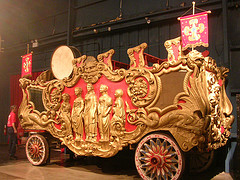 How often are you assuming too much? It’s something you need to think about when you’re engaged in a job hunt. [Read more…] about How NOT to write a resume
How often are you assuming too much? It’s something you need to think about when you’re engaged in a job hunt. [Read more…] about How NOT to write a resume
Your visual resume — do you need a chart to tell your story?
 Today, Penelope Trunk blogged about the value and importance of the visual. She explains in her post, Next phase of your career: Design,”This means that you will be more valuable and more relevant if you can think in terms of visuals.”
Today, Penelope Trunk blogged about the value and importance of the visual. She explains in her post, Next phase of your career: Design,”This means that you will be more valuable and more relevant if you can think in terms of visuals.”
This topic has been on my mind for the past several days, especially, as I have been reviewing Visualize.me, the same infographic tool Penelope highlights in her post. What I’ve been grappling with is the disconnect between what is “cool” and “new” — even cutting edge — and what is actually useful for job seekers.
Remember VisualCV? (Maybe not?) It was an early tool to help job seekers demonstrate their skills and experience online. It was useful for job seekers to be able to pretty easily have online versions of their resumes. However, it turns out VisualCV wasn’t as useful as everyone thought, as it was not helpful for being found online; it was more a mechanism for sharing an online link with people who’d be impressed you had a photo and resume they could see by clicking through. (Update: they are actually closing up shop and won’t exist after December, 2011.)
Today, it’s not very hard to put up information online. There are lots of services making it really easy. Just a few (from my book, Social Networking for Career Success):
http://www.weebly.com/features.html
http://www.wix.com/
http://www.doyoubuzz.com/us/
http://www.zooloo.com/
http://brand-yourself.com/
http://www.webs.com/
http://carbonmade.com/
http://chi.mp/
http://flavors.me/
I believe job seekers should have a social resume — an online place to showcase and highlight their skills, but it’s not always the best idea to jump on the easiest or least expensive service to do it. For one thing, you never know when ads may show up alongside your personal information, or if a service will go under and leave you in the lurch. It’s not always totally intuitive what to include and how to showcase the best you have to offer online — it’s not always a case of “more is better.”
The same goes for infographics, which is why I’ve been reserving judgement and not writing about them. If you’re a graphic artist and create your OWN infographic resume, highlighting and showcasing not only your resume, but the visual skills you will use on the job, there’s no question in my mind a very customized resume along the lines of what Visualize.Me provides is a value add to your job hunt. It’s important to keep an eye on hiring managers in your field and what they need and want, though. It’s possible (likely) their systems still require the more traditional text resume, which you should always have handy. No doubt, there’s a disconnect between what we can create and what hiring managers and systems can use. When even a PDF may not be a good choice, think twice when you apply with a totally visual document.
Knowing how to tell your story — and how to tell it well — is not going out of style, even as the places and ways we showcase what we offer do change. As Penelope reminded us in her post,
“Short is good, and concise is fun, and in a world where we have too many facts, we appreciate a quick picture that synthesizes facts into something meaningful rather than a summary of disjointed facts.”
However, I don’t know that a literal picture is always the best answer to the question of how to demonstrate our value. A story — using words, and a hook to compel the reader to want to know more — can be equally appealing, interesting and attractive.
Infographics are sexy now. A chart is novel, a flow of your work life, especially if it is actually interesting and makes a case to hire you, is a potential positive. However, as with anything job search related, the most important thing to do is consider your target audience and their needs. Unless your chart will be unique and special and appeal to them, I’d think twice before assuming your “outside of the box” approach (and how unique is it really once all of the career bloggers are blogging about it?) is going to be the thing that lands you a job.
I’ve been personally thinking about this as it relates to my website. I’m planning a bit of an overhaul in an effort to bring my site in line with my business objectives. However, I’m still convinced it’s the content on the site and information people find that drives them (you!) here. Hopefully, the visual experience right now is pleasant, but I’m guessing I could have the most beautiful, cutting-edge visual site, but if I couldn’t support it with content, I’d have a lot less visitors.
Focus on being able to tell your story – IN WORDS – in a way that is as appealing and attractive as a pretty chart, and I’m betting you will be far ahead of the crowd.
photo by roger4336
Thoughts about volunteering and job hunting on a National Day of Service
Last week, there was news from LinkedIn about their new section allowing users to highlight their volunteer experiences, organizations you support and causes important to them. (You can read their blog announcing this news.)
I’ve written about how job seekers can help turn volunteer efforts into a job. I’ve linked to the Encore.org site, which has a very useful (and free) ebook on the subject. They suggest:
- Find volunteer work in an organization whose mission you share.
- Offer your expertise.
- Show your range.
- Make yourself indispensable.
- Identify an organizational need.
- Incorporate your volunteer work into your resume.
The ebook (available to download HERE) offers practical tips and resources and reminds careerists to focus on the experience and its usefulness rather than expect that it will lead to a job.
Volunteering has many good potential outcomes. Some people volunteer to do work to gain experience (via internships, for example), or offer their services free of charge in order to keep their skills up when they are not engaged in paid opportunities. Others recognize the value of working with and meeting people who share a passion or interest. They may volunteer first because that is what they enjoy doing, but may also reap some secondary benefits — meeting new friends and contacts.
All of this is important to remember, but what is the best way to highlight volunteer experience if you’re job hunting? Even though LinkedIn now provides a whole, separate place to focus on your volunteer work, I usually advise clients to consider showcasing in-depth, significant volunteer work as “experience,” without specifically highlighting it as “volunteer work.”
There is no reason to designate your experience on your resume or job search materials as “for pay” and “unpaid.” Your experience is your experience, and if you have been engaged in working for or with an organization, and have skills to describe and accomplishments to showcase, it’s appropriate to do so within the “Experience” section. If interviewers ask if the work was a volunteer efforts, feel free to share why you chose that organization and highlight your altruism after you explain your accomplishments and the skills you used.
I think it’s great LinkedIn is giving everyone a place to showcase their favorite causes, but don’t include your work-focused volunteer efforts in the new section INSTEAD of in the regular experience section. Feel free to continue to highlight your experience as just that — EXPERIENCE!
Improve your resume by asking yourself, “So what?”
 Last week, I had a chance to join CNN anchor Fredricka Whitfield on the air to provide tips for job seekers. We went over some “before” and “after” resumes. Here’s part 2 of a several-part series dedicated to improving your resume. (Don’t miss part 1, showcasing resume headers.)
Last week, I had a chance to join CNN anchor Fredricka Whitfield on the air to provide tips for job seekers. We went over some “before” and “after” resumes. Here’s part 2 of a several-part series dedicated to improving your resume. (Don’t miss part 1, showcasing resume headers.)
OLD RESUME
PROFESSIONAL EXPERIENCEÂ
Managing Web Editor, XYZ Company
New York, NYÂ March 2008 – Present
-Manage high-traffic Web site for 1.5-million member organization.
-Edit and write content for Web magazine, marketing materials and internal memos and reports.
-Project manager for Web site overhaul. This includes planning and testing design, navigation and developing streamlined functionality to stimulate e-commerce activities.
How could this description be improved?
- Underlines look dated. Usually, you’ll only include months in the date section if the experience was one year or less.
- Bullet points shouldn’t just list WHAT you did, but focus on HOW you did it so it relates to the employer. Decide what they need you to do and show that on your resume. Ask yourself, “SO WHAT?†for every bullet point and provide an answer in your resume. Incorporate skills and accomplishments when giving the answer.
- Be sure all bullets are consistent – parallel tense. Begin each with a verb: manage, edit and “project manager†don’t match.
- Don’t make your resume a laundry list of “stuff†you’ve done.
NEW RESUME
CAREER ACHIEVEMENTS
Managing Web Editor, XYZ Company New York, NY  2008 – Present
- Analyzed site traffic using Google Analytics, Lyris HQ Agency Edition and SiteCatalyst. Identified strategic patterns, trends and popular content and recommended changes to site, resulting in 17% increase in page views in only three months.
- Supervised site’s overhaul in compliance with company’s goals. Conducted needs assessment, identified market opportunities and planned and tested design, which stimulated e-commerce and increased profitability from $15M to $20M in 2010.
- Authored content for Web and email newsletters and created and recorded podcasts highlighting organization’s mission. Management attributed increased membership rates to high-quality online and audio content.
What is better about this description?
- Decide if your title or the organization name is more important. In this case, the resume focuses the reader on job titles. Be consistent across the entire resume.
- Incorporate details important to the employer. Use key words (for example, the names of the programs to analyze site traffic).
- Show your impact – use $ amounts, %ages and other numbers when possible. (These answer the question, “So what?”)
photo by y-a-n
Stay tuned for another post with resume tips!
Improve your resume using these tips
 Last week, I had a chance to join CNN anchor Fredricka Whitfield on the air to provide tips for job seekers. We went over some “before” and “after” resumes. Here’s part 1 of a several-part series dedicated to brushing up and improving your resume.
Last week, I had a chance to join CNN anchor Fredricka Whitfield on the air to provide tips for job seekers. We went over some “before” and “after” resumes. Here’s part 1 of a several-part series dedicated to brushing up and improving your resume.
Review these suggestions to see if there are any changes you may want to incorporate in your resume.
OLD HEADER
Jill Jack
123 Main Street – New York, NY – 212-555-0000 – Jill.Jack@hotmail.com
Objective
Innovative, highly motivated, dynamic team player with extensive experience, stellar writing skills and the ability to effectively manage concurrent projects seeks opportunity to contribute in Fortune 500 Company.
What’s wrong with this header?
- It does not include social media references, and relies on an old-fashioned email address. (While I, personally, don’t discriminate against an “AOL,” or “Hotmail” address, it can make you appear a little dated and not in tune with modern technology.) Consider a Gmail account, with the added benefit of a Google profile.
- I do not recommend using an objective. Your objective is to get the job. Use that space to include headlines and bullet points describing your fit for the job. In addition, the objective here uses overused words (innovative, highly motivated, dynamic extensive experience). These words are not very descriptive; avoid “empty†words in your resume.
- It doesn’t have a clear focus or specific job goal.
- It’s difficult to tell here, but the font is Times New Roman. Consider choosing a more updated font, such as Trebuchet, Verdana, Calibri or Tahoma.
NEW HEADER
Jill Jack
123 Main St. – New York, NY – 212.555.0000 – JillJack@gmail.com
http://www.linkedin.com/in/JillJack – @JillJack – gplus.to/JillJack – JillJack.com
Multimedia Manager — Communications Strategist — Content Developer
Market savvy, writer/editor experienced in producing profitableonline, video and ezine content.
“Jill combines a flair for the creative, an intuitive understanding of market trends and consumer needs with her unbeatable technical, writing, editing and management skills. I’ve never known anyone who can evaluate the landscape, design a strategy and execute on plans as well as Jill.â€
– Peter Pan, Overseeing Editor, XYX Company (View this and other endorsements via LinkedIn)
What’s better about this header?
- It incorporates social media URLs – indicating this person is involved online and up-to-date. By inviting the reader to review her Twitter stream and LinkedIn profile for additional information, it’s clear (no matter how old this job seeker may be), the candidate is an early adopter (showing a Google+ account) and clearly willing to learn new things. Only showcase these URLs if you are using social media professionally. However, don’t assume no one will find your Twitter and other social media outlets.
- Notice this resume includes a link to the job seeker’s personal website/social resume. Having this online portfolio really demonstrates she is using technology and is up-to-date.
- This header uses important resume “real estate†at the top of the document to hone in on important points: job titles and key skills. It avoids “empty†words that don’t describe a connection between the candidate and the job. It’s important to select KEY words from job descriptions, company websites and LinkedIn profiles from others in your industry.
- It includes a recommendation from someone found on LinkedIn. This is a great way to help tell your story and to prove your qualifications from an outside perspective.
Watch the video here:
Stay tuned for more tips to help you evaluate and improve your resume!
photo by cobalt123